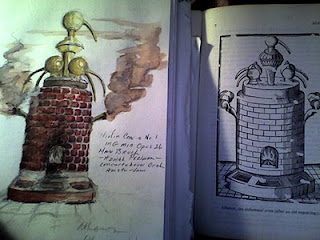
When I checked my Cirlot (Diccionario De Simbolos Traditionales) for chimneys there was a conspicuous absence between Chimaera and Choice. This will not do. It is a problem. As usual, we must rely on our own resources, minds and memories to solve it. We can thumb through the book to related things, things that have chimneys, like ovens. Cirlot includes Athanor --the alchemists' oven-- but its chimney is really a combined distillery and refinery, therefore another sort of thing.
Yet, we can't entirely dismiss Athanor. The gross tar from its lower regions has much to do with the mind. However much of mind is machine, you can't gum it up with shoddy ideas and expect it to work properly. Joel Chandler Harris showed how selfish, contentious characters can imprison themselves by attacking tarballs. British Petroleum and the US government are currently demonstrating this principle on our Gulf Coast. Certainly, to settle for something less than optimal mental function, when truth is available, is morbid self-betrayal.
Let us examine regular chimneys. Santa Claus comes down them and leaves some gifts, unless I am naughty --in which case he leaves a lump of coal. Coal is fuel for further combustion, symbolizing Santy's hope that next year I shall have been good. The Ifrit, of "1001 Nights", is summoned by writing God's name in Hebrew, and, like Santy, implies judgement. Mostly, these Genies rise from lamp chimneys to trick us if we're too selfish with our wishes. So there's some danger involved.
The greatest danger has to do with wicked demons like succubi. The succubus is a pretty girl-demon who has sex with guys and steals their immortal souls. Although guys don't usually mind, the church frowns on it. In fact, it's churches that promulgated the superstition that chimneys, unlike doors and windows that close, are particularly vulnerable to evil. Gargoyles and scary sculpture at cathedral chimneys are intended as apotropaic magic to keep succubi and other moogies out. Complete absence of sexual temptation in the church is unimpeachable evidence that these wards have held.
Apotropaic --Greek for evil-averting-- magic needn't be architectural. The Nazar, or evil-eye, stone is common in Greece and Turkey, which brings us closer to the geographical origin of magical chimney infestations. Earliest written record being in Sumerian cuneiform dating back to 4000 B.C. I refer, of course, to the legend of De-dal Nita, "The Soot-Husband".
Unlike succubi, the Soot-Husband would come down the chimney into the dreams of unappreciated women, not to steal their souls but to praise them, massage them, and do for them in every kind and gentle way (Sum.:Gisdu-hili). There was, however, a judgement involved. At the end of these attentions, the Soot-Husband would curl up at the foot of the bed with the cheerful words, "Good-night, just kick me in the head if you need me!"
If the woman woke wanting more from the Soot-Husband and did indeed kick him in the head, she would be judged selfish and unworthy. The spirit would evacuate its base carbon body and the all the woman got was Salamu-sepu, or "sooty-footy". The story spread quickly through Sumeria and, because it reflected their shortcomings, men got upset about it. They created the story of Akhkaru, "Vampire", to defame Soot-Husband, but strangely, women sort of liked that one too.
I'm sorry! I haven't been -that online for this one.
ReplyDeleteUmma.
Will
Sumerian "Umma" is now called "Tell Jokha". I think you got it, Will.
ReplyDelete